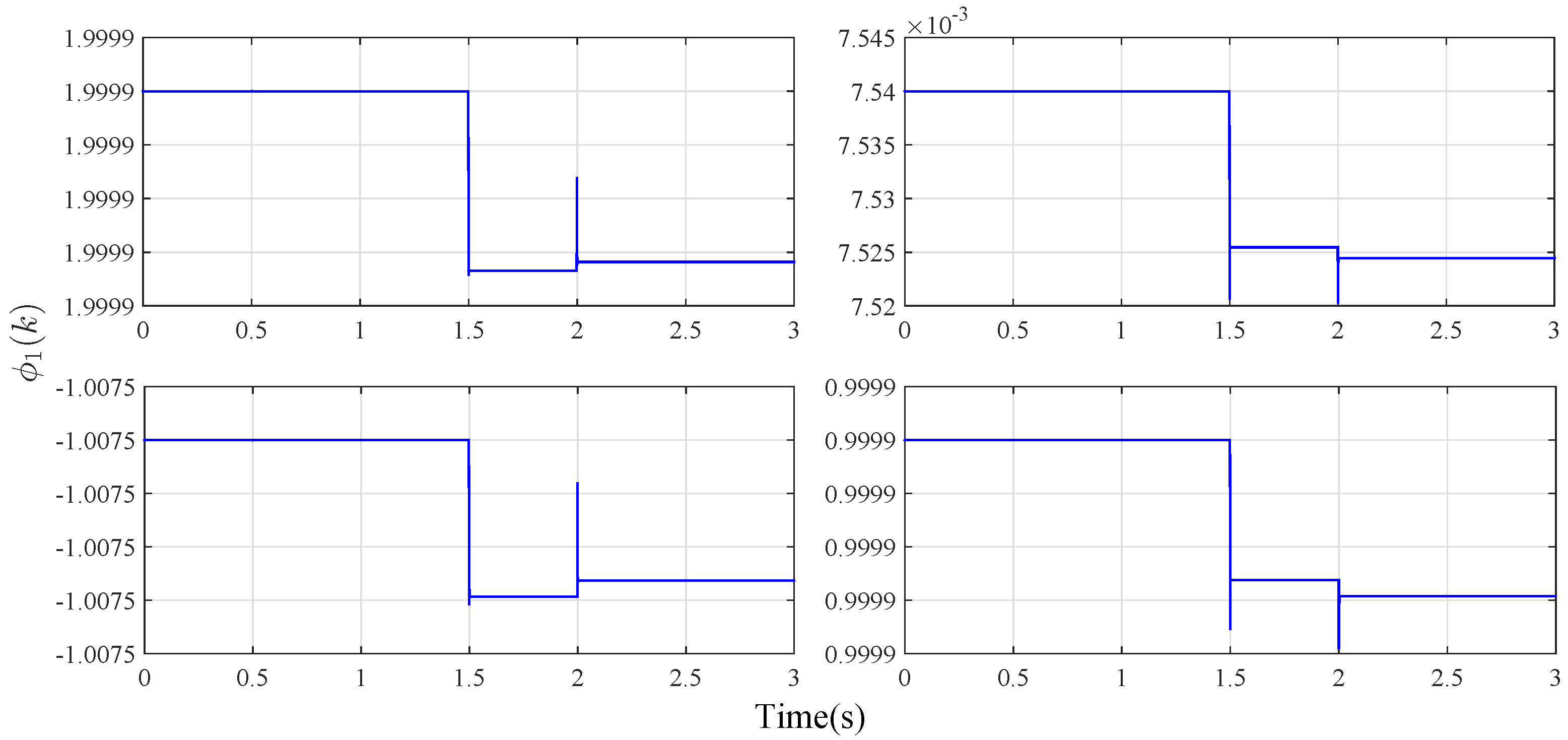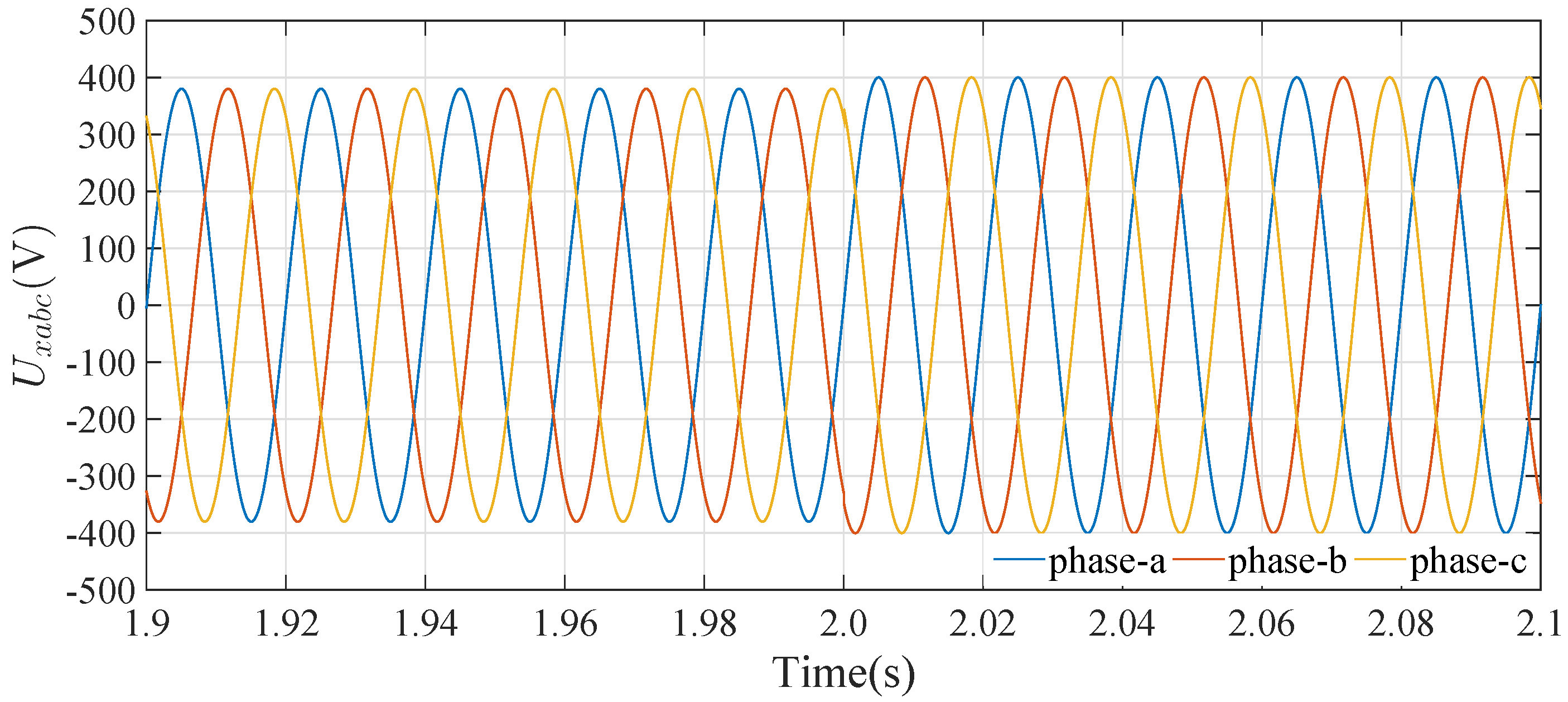Adaptive-Observer-Based Data Driven Voltage Control in Islanded-Mode of Distributed Energy Resource Systems
Abstract
:1. Introduction
- The model-free control method is applied to the voltage control of the DER system, which reduces the dependence of the controller on model information.
- The PPD parameter estimation algorithm is designed based on the multiple observer technique, which can guarantee the errors of observation converge to 0.
- We utilize the novel transformation and linearization technique for the islanded DER system dynamics. The main advantage of this method is that the dynamics of the MIMO DER system are transformed and linearized properly for the proposed MFAC algorithm.
- By constructing the Lyapunov function, it is theoretically proven that all the signals in the closed-loop control system are bounded.
2. Dynamics Transformation and Linearization of Islanded DER System
2.1. Mathematic Model of the Islanded DER System
2.2. Dynamics Transformation and Linearization Technique
3. Multiple Observer-Based Model-Free Adaptive Control Design for DER System
3.1. Multiple Observer-Based PPD Parameter Estimation Algorithm
3.2. Controller Design and Stability Analysis
4. Simulation Results
5. Conclusions
Author Contributions
Funding
Conflicts of Interest
References
- Karimi, H.; Nikkhajoei, H.; Iravani, M.R. Control of an electronically-coupled distributed resource unit subsequent to an islanding event. IEEE Trans. Power Deliv. 2008, 23, 493–501. [Google Scholar] [CrossRef]
- Lew, D.; Asano, M.; Boemer, J.; Ching, C.; Focken, U.; Hydzik, R.; Lange, M.; Motley, A. The power of small: the effects of distributed energy resources on system reliability. IEEE Power Energy Mag. 2017, 15, 50–60. [Google Scholar] [CrossRef]
- Sajadian, S.; Ahmadi, R. Model Predictive Control of Dual-Mode Operations Z-Source Inverter: Islanded and Grid-Connected. IEEE Trans. Power Electron. 2018, 33, 4488–4497. [Google Scholar] [CrossRef]
- Chen, Z.; Luo, A.; Wang, H.; Chen, Y.; Li, M.; Huang, Y. Adaptive sliding-mode voltage control for inverter operating in islanded mode in microgrid. Electr. Power Energy Syst. 2015, 66, 133–143. [Google Scholar] [CrossRef]
- Yazdani, A. Control of an islanded distributed energy resource unit with load-compensating feed-forward. In Proceedings of the IEEE Power and Energy Society General Meeting, PES08, Pittsburgh, PA, USA, 20–24 July 2008. [Google Scholar] [CrossRef]
- Karimi, H.; Nikkhajoei, H.; Iravani, R. A linear quadratic gaussian controller for a stand-alone distributed resource unit-simulation case studies. In Proceedings of the IEEE Power Engineering Society General Meeting, PES07, Tampa, FL, USA, 24–28 June 2007. [Google Scholar] [CrossRef]
- Li, Y.; Vilathgamuwa, D.M.; Loh, P.C. Design, analysis, and real-time testing of a controller for multibus microgrid system. IEEE Trans. Power Electron. 2004, 19, 1195–1204. [Google Scholar] [CrossRef]
- Sao, C.K.; Lehn, P.W. Control and power management of converter fed microgrid. IEEE Trans. Power Syst. 2008, 3, 1088–1098. [Google Scholar] [CrossRef]
- Delghavi, M.B.; Yazdani, A. Islanded-mode control of electronically coupled distributed-resource units under unbalanced and nonlinear load conditions. IEEE Trans. Power Deliv. 2011, 26, 661–673. [Google Scholar] [CrossRef]
- Huerta, H.; Loukianov, A.; Canedo, J. Multimachine power-system control: integral-SM approach. IEEE Trans. Ind. Electron. 2009, 56, 2229–2236. [Google Scholar] [CrossRef]
- Loukianov, A.; Canedo, J.; Utkin, V.; Cabrera-Vazquez, J. Discontinuous controller for power systems: sliding-mode block control approach. Trans. Ind. Electron. 2004, 51, 340–353. [Google Scholar] [CrossRef]
- Vargas, J.; Ledwich, G. Variable structure control for power systems stabilization. Electr. Power Energy Syst. 2010, 32, 101–107. [Google Scholar] [CrossRef]
- Delghavi, M.B.; Shoja-Majidabad, S.; Yazdani, A. Fractional-Order Sliding-Mode Control of Islanded Distributed Energy Resource Systems. IEEE Trans. Sustain. Energy 2016, 7, 1482–1491. [Google Scholar] [CrossRef]
- Chang, F.; Chang, E.; Liang, T.; Chen, J. Digital-signal-processor-based DC/AC inverter with integral-compensation terminal sliding-mode control. IET Power Electron. 2011, 4, 159–167. [Google Scholar] [CrossRef]
- Su, X.; Han, M.; Guerrero, J.M.; Sun, H. Microgrid stability controller based on adaptive robust total SMC. Energies 2015, 8, 1784–1801. [Google Scholar] [CrossRef] [Green Version]
- Hou, Z.; Jin, S. A novel data-driven control approach for a class of discrete-time nonlinear systems. IEEE Trans. Control Syst. Technol. 2011, 19, 1549–1558. [Google Scholar] [CrossRef]
- Hou, Z.; Jin, S. Data driven model-free adaptive control for a class of MIMO nonlinear discrete-time systems. IEEE Trans. Neural Netw. 2011, 22, 2173–2188. [Google Scholar] [CrossRef] [PubMed]
- Hou, Z.; Wang, Z. From model-based control to data-driven control: survey, classification and perspective. Inf. Sci. 2013, 235, 3–35. [Google Scholar] [CrossRef]
- Xu, D.; Jiang, B.; Shi, P. A novel model free adaptive control design for multivariable industrial processes. IEEE Trans. Ind. Electron. 2014, 61, 6391–6398. [Google Scholar] [CrossRef]
- Zhang, H.; Zhou, J.; Sun, Q.; Guerrero, J.M.; Ma, D. Data-Driven Control for Interlinked AC/DC Microgrids Via Model-Free Adaptive Control and Dual-Droop Control. IEEE Trans. Smart Grid 2017, 8, 557–571. [Google Scholar] [CrossRef]
- Xu, D.; Jiang, B.; Shi, P. Adaptive observer based data-driven control for nonlinear discrete-time processes. IEEE Trans. Autom. Sci. Eng. 2014, 11, 1037–1045. [Google Scholar] [CrossRef]
- Zhu, Y.; Hou, Z. Data-Driven MFAC for a Class of Discrete-Time Nonlinear Systems With RBFNN. IEEE Trans. Neural Netw. Learn. Syst. 2014, 25, 1013–1020. [Google Scholar] [CrossRef] [PubMed]
- Zhao, Y.; Yuan, Z.; Lu, C.; Zhang, G.; Li, X.; Chen, Y. Improved model-free adaptive wide-area coordination damping controller for multiple-input-multiple-output power systems. IET Gener. Transm. Distrib. 2016, 10, 3264–3275. [Google Scholar] [CrossRef]
- Bu, X.; Hou, Z.; Liang, J.; Xu, P. Data driven multiagent systems consensus tracking using model free adaptive control. In Proceedings of the 2016 28th Chinese Control and Decision Conference (CCDC), Yinchuan, China, 28–30 May 2016. [Google Scholar] [CrossRef]
- Lu, X.P.; Li, W.; Lin, Y.G. Load control of wind turbine based on model-free adaptive controller. Trans. Chin. Soc. Agric. Mach. 2011, 42, 109–114. [Google Scholar]
- Gao, B.; Gu, K.Y.; Zeng, Y.; Chang, Y. An anti-suction control for an intra-aorta pump using blood assistant index: a numerical simulation. Artif. Organs 2012, 36, 275–285. [Google Scholar] [CrossRef] [PubMed]
- Spooner, J.; Maggiore, M.; Passino, K. Stable Adaptive Control and Estimation for Nonlinear Systems; Wiley Interscience: Hoboken, NJ, USA, 2002; Volume 36, pp. 275–285. ISBN 0471415464. [Google Scholar] [CrossRef]
- Astrom, K.; Johansson, K.; Wang, Q. Design of decoupled PI controllers for two-by-two systems. IEE Proc. Control Theory Appl. 2002, 149, 74–81. [Google Scholar] [CrossRef] [Green Version]









| Load Types | Characteristics | Transformer |
|---|---|---|
| Balanced | three star-connected | |
| Load | series RL circuits with | 4.13/0.675 |
| m and | kVrms | |
| H | ||
| Unbalanced | series RL between each phase | |
| Load | and neutral with | 4.13/0.21 |
| m, H | kVrms | |
| m, H | ||
| m, H |
| Parameters | Value | Description |
|---|---|---|
| H | ||
| C | F | |
| R | m | |
| 1800 V | dc-link voltage | |
| w | 314 rad/s | nominal angular frequency |
| 4.13/ 0.675 kVrms | leakage reactance |
© 2018 by the authors. Licensee MDPI, Basel, Switzerland. This article is an open access article distributed under the terms and conditions of the Creative Commons Attribution (CC BY) license (http://creativecommons.org/licenses/by/4.0/).
Share and Cite
Xia, Y.; Dai, Y.; Yan, W.; Xu, D.; Yang, C. Adaptive-Observer-Based Data Driven Voltage Control in Islanded-Mode of Distributed Energy Resource Systems. Energies 2018, 11, 3299. https://doi.org/10.3390/en11123299
Xia Y, Dai Y, Yan W, Xu D, Yang C. Adaptive-Observer-Based Data Driven Voltage Control in Islanded-Mode of Distributed Energy Resource Systems. Energies. 2018; 11(12):3299. https://doi.org/10.3390/en11123299
Chicago/Turabian StyleXia, Yan, Yuchen Dai, Wenxu Yan, Dezhi Xu, and Chengshun Yang. 2018. "Adaptive-Observer-Based Data Driven Voltage Control in Islanded-Mode of Distributed Energy Resource Systems" Energies 11, no. 12: 3299. https://doi.org/10.3390/en11123299




